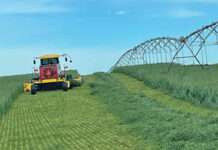K-State expert offers advice on protecting home lawn
MANHATTAN, Kan. – Considering they spend most of their time underground, it may seem surprising the damage that moles do above ground.
As they forage for food, moles are known to make travel lanes that cause meandering paths of upheaved soil in home lawns and farmsteads. Moles do not feed on plant matter, but they can still cause damage by disturbing roots and uprooting small plants.
Some tunnels may be abandoned soon after they’re built, while others are used for a period of time.
Kansas State University horticulture expert Ward Upham said homeowners have come up with many remedies – chewing gum, noisemakers, broken glass, bleaches, windmills and human hair among them – but none have provided consistent or reliable control.
“Poison baits also fail to work because moles feed on earthworms and grubs, not vegetable matter,” Upham said. “Even grub control products are ineffective because they do not control earthworms,” which are the primary food source for moles.
Grim as it may sound, traps are the best control method for moles, according to Upham.
“There are three types of traps: harpoon, choker and scissor-jawed,” he said. “Each can be effective but may take some time to master.”
He offered the following advice:
• Because moles use some tunnels more than others, use a broomstick or similar item to poke holes in a number of runs. Check a day later to see which runs have been repaired. These are the active runs.
• Place a trap in an active run by excavating soil, placing the trap and then replacing loose soil. Secure the trap so that the recoil will not lift the trap out of the ground. Make sure the triggering mechanism is not in the center of the run.
• Push down two holes, one on each side of the trap. Moles should be caught when they try to repair the tunnel. Move the traps if no moles are caught within three days.
More information on preventing mole damage in home lawns or on a farm is available online from the K-State Research and Extension wildlife management program.
Upham and his colleagues in K-State’s Department of Horticulture and Natural Resources produce a weekly Horticulture Newsletter with tips for maintaining home landscapes. The newsletter is available to view online or can be delivered by email each week.
Interested persons can also send their garden- and yard-related questions to Upham at [email protected], or contact your local K-State Research and Extension office.
-30-
FOR PRINT PUBLICATIONS: Links used in this story
K-State Research and Extension wildlife management (moles), www.wildlife.k-state.edu/species/moles/index.html
K-State Horticulture Newsletter, https://hnr.k-state.edu/extension/info-center/newsletters/index.html
K-State Research and Extension local offices, www.ksre.k-state.edu/about/stateandareamaps.html
K State Research and Extension is a short name for the Kansas State University Agricultural Experiment Station and Cooperative Extension Service, a program designed to generate and distribute useful knowledge for the well being of Kansans. Supported by county, state, federal and private funds, the program has county extension offices, experiment fields, area extension offices and regional research centers statewide. Its headquarters is on the K State campus in Manhattan. For more information, visit www.ksre.ksu.edu. K-State Research and Extension is an equal opportunity provider and employer.
Story by:
Pat Melgares
[email protected]
785-532-1160
For more information:
Ward Upham
[email protected]
785-532-6173




